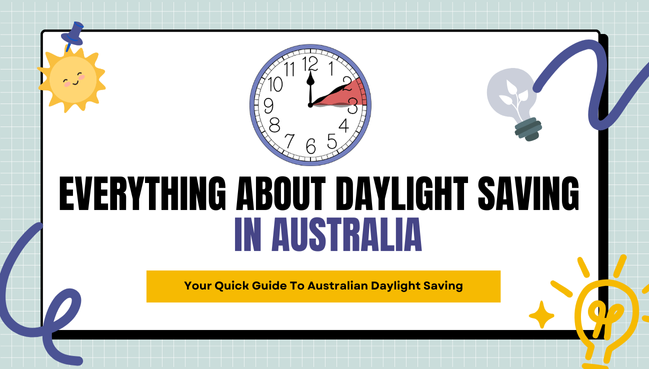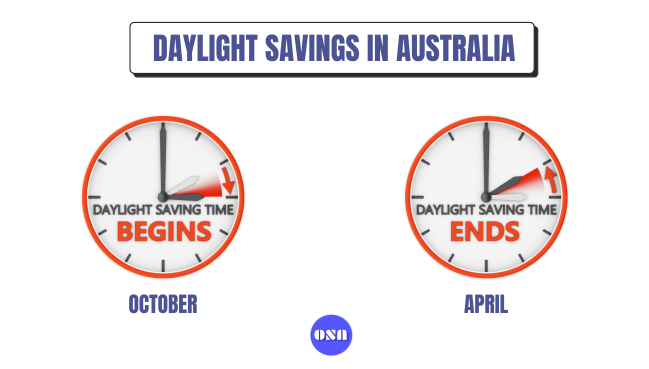Everything You Need To Know About Daylight Saving In Australia

Many international students who come to study in Australia get to know about a new term they never hear of before “Daylight Saving”?
Does that mean we save the Daylight? or does it mean using solar panels to capture daylight in the summer days?
Well, none of that.
So in this article, we are explaining everything you need to know about Daylight Saving in Australia.
What is Daylight Saving?
Daylight Saving Time (DST) is advancing the clocks one hour forward during the summer months. The idea behind daylight saving is to enjoy one extra hour of daylight in the evenings.
It makes your day feeling longer and also helps to save the consumption of electricity and hence helping the planet a bit.
When did it first started?
The idea was first proposed by George Hudson, an astronomer from New Zealand in 1895.
However, it was first used by the residents of Port Arthur, Ontario, Canada in 1908.
Australia first observed its Daylight Saving Time (DST) in 1916. Although it wasn’t until 1967 when the practice of daylight saving became more regular after drought in Tasmania. Other states picked up the practice in 1970s.
It might be surprise for some that Australia is not the only country that observes daylight saving. There are 70 countries around the world that participate in the daylight saving.
Which states and territories recognise daylight savings in Australia?
In Australia, these states and territories recognise the daylight savings:
✔️ New South Wales
✔️ Victoria
✔️ Tasmania
✔️ South Australia
✔️ Australian Capital Territory
So if you are living in:
❌ Queensland
❌ Northern Territory
❌ Western Australia
You don’t need to worry about daylight saving except when travelling interstate or dealing with people from those states and territories with daylight savings.
When does Daylight saving start and end in Australia?
In Australia, Daylight saving start at 2 am on the first Sunday of October and ends at 2 am on the first Sunday of April.
In 2025-26, the daylight savings will start on 5th October 2024 at 2 am and end on Sunday, 5th April 2026 at 2am in Australia
In the table below, you can see the Daylight Savings start and end times for the next few years in Australia.
| Year | Daylight Savings Starts | Daylight Savings Ends |
|---|---|---|
2025 – 2026 | October 5, 2025 | April 5, 2026 |
| 2026 – 2027 | October 4, 2026 | April 4, 2027 |

What should I do for Daylight Saving changes?
If you are living in any of the states and territories in Australia where Daylight Savings are observed, then all you need to do is forward your clock by 1 hour on the first Sunday of October and move it backwards on the first Sunday of April.
You usually don’t need to change the time on your mobile devices as it is automatically changed by your mobile network provider.
You lose an hour of sleep when daylight saving starts, but you get it back when daylight saving ends.
If you are living in other parts of Australia that does not recognise daylight saving, then you don’t need to do anything. Life goes on for you as per normal except if you have to deal with people living in Daylight Savings time zones.
How to prepare yourself better for Daylight Savings changes?
But if you want to prepare yourself better for Daylight Savings changes, we suggest you:
- Adjust your sleep cycle: Before the time changes, it will be great if you can adjust your time schedule for sleeping. For example, if you typically go to bed at 11 PM and get up at 6 AM, you can start going to bed 15 to 30 minutes earlier each night in the week leading up to the Daylight Saving changes.
- Check the time for public transport: To avoid any possible work-related delays, it is best to check the local transport schedule to see if any changes have been made.
- Plan your meal and exercise timings: You can start planning your meal schedules and exercise timings as well before the start of the Daylight savings.
- Be patient: Last but not the least, Daylight Savings can disrupt your life patterns, but it will be only a few weeks before you start adjusting back to the new time. So don’t stress. Give yourself extra self-care time after the change to Daylight Saving timeframes.
Which countries observe Daylight Savings?
There area around 70 countries around the world that observe Daylight Savings including:
✔️ Australia
✔️ Brazil
✔️ Canada
✔️ Chile
✔️ Fiji
✔️ Mexico
✔️ New Zealand
✔️ United States
✔️ United Kingdom
✔️ Most Eurpoean Union
✔️ Some Middle Eastern Countries
What are the benefits of Daylight Savings?
Here are some benefits of having a Daylight Savings:
- Energy savings: The benefit of observing a Daylight Savings is that it leads to energy savings. This is due to the fact that people tend to use less electricity due to the longer day hours. T
- Longer evenings for outdoor activities: Daylight Savings gives people more time to spend outside in the evenings. It can be good for outdoor activities such as sports.
- Great for Economy: As people tend to spend more time outdoors, it turns out that they spend more money, which helps the local economy.
What are the drawbacks of Daylight Savings?
Here are common drawbacks of having a Daylight Savings:
- Disruption to sleep patterns: DST can cause disruption to sleep patterns, as people may have to wake up earlier and go to bed later than usual.
- Negative impact on some businesses: Some businesses that tend to deal with people from different states or countries with different timezones may have impact on their operations.
Does the Daylight Savings affect your health?
Although, some reports do suggest that it can disrupt your sleeping pattern, food habits, appetite etc. temporarily.
There is no scientific evidence that it poses serious threats to your body. You might feel a bit tired due to lack of sleep when daylight saving starts. It can take some time for your body to adjust to the new timing as well.
What do you think about Daylight Saving? Do you like it or not? Give your thoughts in the comments below.


